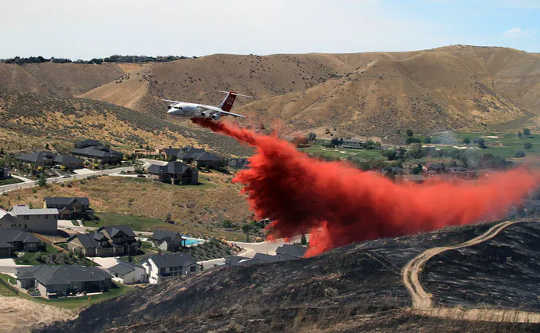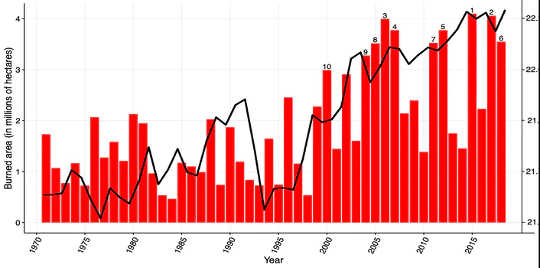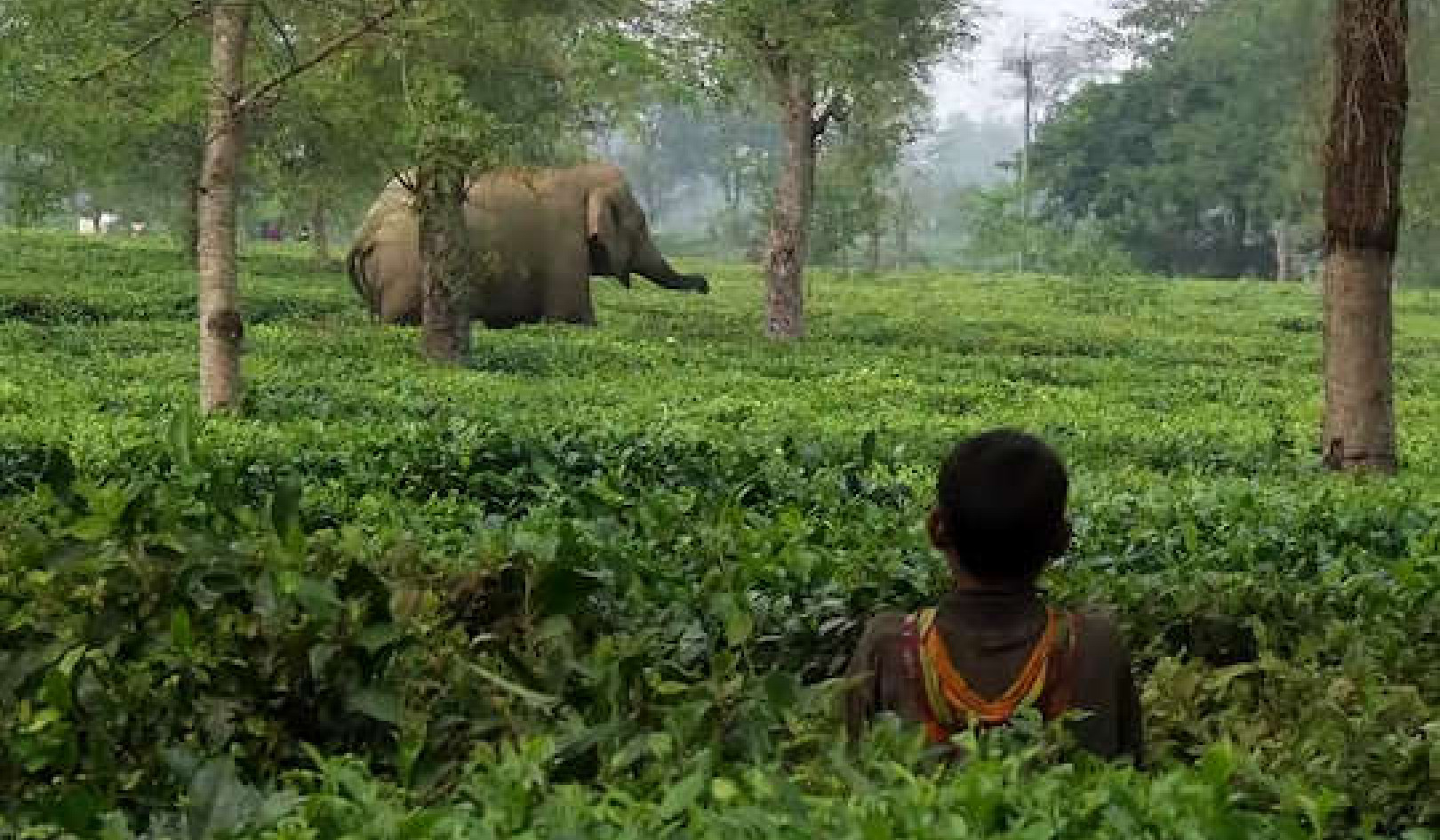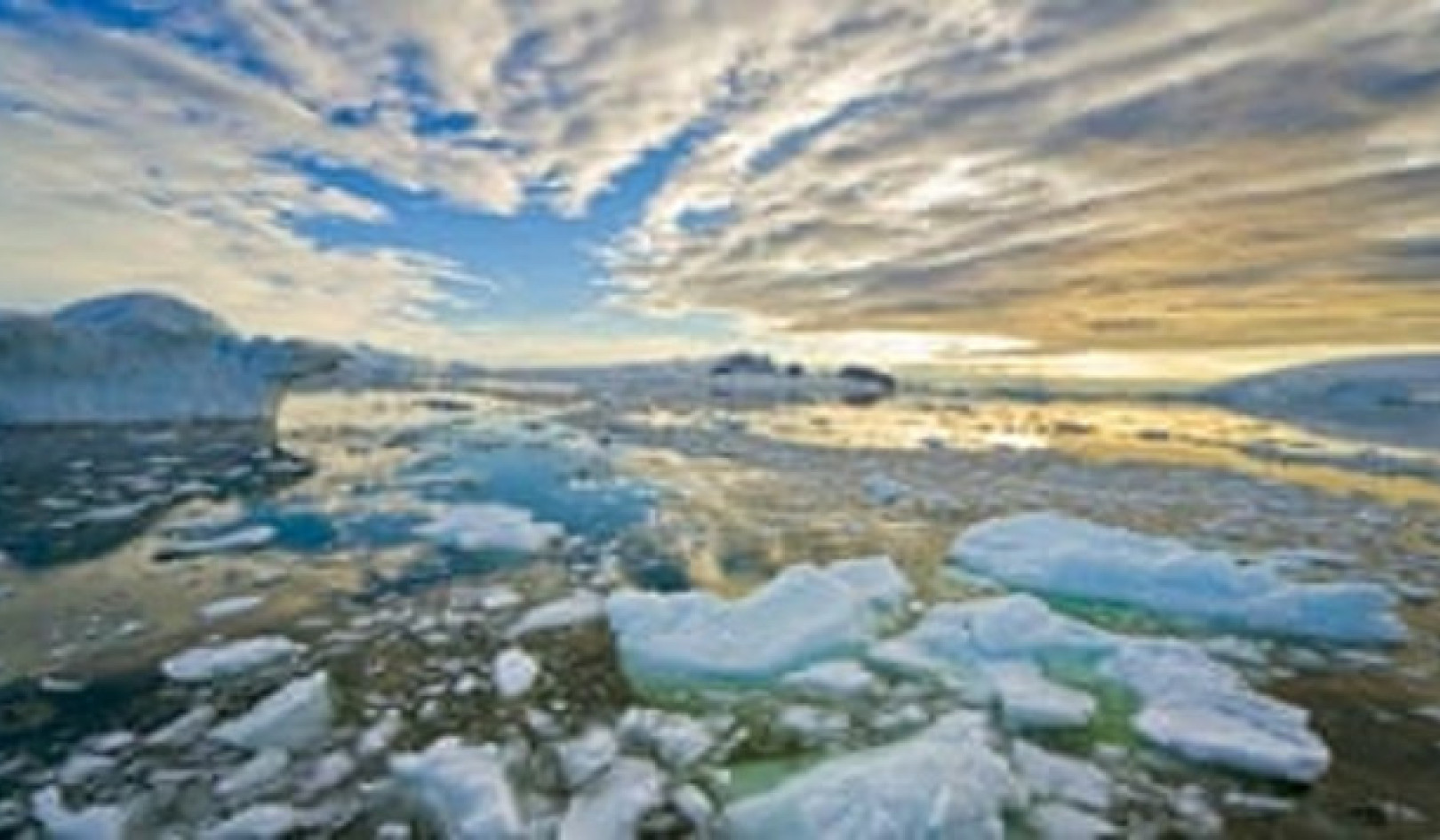
An airtanker drops retardant to help stop the spread of the 2015 Eyrie Fire in the foothills of Boise, Idaho, which was ignited by sparks from construction equipment. Austin Catlin, BLM/Flickr
Summer and fall are wildfire season across the western U.S. In recent years, wildfires have destroyed thousands of homes, forced hundreds of thousands of people to evacuate and exposed tens of millions to harmful smoke.
Wildfires are a natural disturbance for these regions, but when combined with climate change and housing growth in the wildland-urban interface – zones where development has spread into wild areas – they have become larger and more destructive.
30,000 firefighters today are on the blazes. 94 active & big wildfires. We’re asking too much of our firefighters. Thanks @smerconish for the opportunity to share some key fire science. https://t.co/yeFvbWZBqO
— Jennifer Balch (@DrBalch) September 14, 2020
To make matters worse, humans are responsible for starting almost all the wildfires in developed areas that threaten U.S. homes. In a newly published study, we show that through activities like debris burning, equipment use and arson, people ignited 97% of home-threatening wildfires in the wildland-urban interface between 1992 and 2015. For comparison, when fires in undeveloped areas are also counted, humans started 84% of all wildfires between 1992 and 2012, with lightning as the main natural cause.
Common and costly
Wildfires in developed areas threatened one million homes across the lower 48 states that sat within their boundaries in the years we reviewed in our study. This figure is five times larger than previous estimates, which did not consider the threat of small fires – those measuring less than 1.5 square miles (4 square kilometers).
Human-started fires in these zones carry a high price tag. Over 15 years, between 2000 and 2014, state and local governments spent US$4.1 billion fighting wildfires near homes. That’s equivalent to one-third of the national wildfire control budget, even though the wildland-urban interface represents only 10% of U.S. land area.
And development in these areas is increasing. Between 1990 and 2015, 32 million new homes were built in the wildland-urban interface – a 145% increase.
Climate change is adding to the problem by making much of the U.S. West hotter and drier, and thus more prone to burn. Warming that has already occurred is linked to a doubling of cumulative burned area across Western U.S. forests since 1984.
 Since 2000, wildfires have burned 10 of the largest areas since 1970. During these years, average U.S. summertime (June- August) temperatures rose steadily. (Fire data from NIFC, temperature data from NOAA). Nathan Mietkiewicz, CC BY-ND
Since 2000, wildfires have burned 10 of the largest areas since 1970. During these years, average U.S. summertime (June- August) temperatures rose steadily. (Fire data from NIFC, temperature data from NOAA). Nathan Mietkiewicz, CC BY-ND
As warming continues, small fires started by people either accidentally or deliberately in the wildland-urban interface could grow into large fires. Longer fire seasons, increased burning and having more homes to protect pose a potentially insurmountable resource challenge.
But the fact that people start the vast majority of wildfires that threaten homes also means it is possible to remove these wildfires from the equation. The way to do this is by altering common human behaviors that introduce ignitions. Key solutions may include:
– Doing more routine maintenance of infrastructure, such as electric power lines.
– Organizing campaigns to reduce use of fireworks and other explosives.
– Limiting use of motorized equipment for yard work and banning debris burning during hot and dry conditions.
– Conducting more planned burns in high-risk areas like the wildland-urban interface during low-fire risk times of year. This work should target areas in these zones where ignition rates and threats to homes are high. These areas should receive high priority for fuel treatments or prescribed burning as preventative measures.
Current trends suggest that people are not going to stop moving to beautiful but flammable areas. This means that more homes will be vulnerable to wildfires, and more people will be engaging in activities that could start them. We think it’s time for Smokey Bear to move to the suburbs, with a new slogan: “Only you can prevent wildfires that threaten your home.”
About the Authors
Nathan Mietkiewicz, Data Scientist, National Ecological Observatory Network and Jennifer Balch, Associate Professor of Geography and Director, Earth Lab, University of Colorado Boulder
This article is republished from The Conversation under a Creative Commons license. Read the original article.
Related Books
Life After Carbon: The Next Global Transformation of Cities
by Peter Plastrik , John Cleveland The future of our cities is not what it used to be. The modern-city model that took hold globally in the twentieth century has outlived its usefulness. It cannot solve the problems it helped to create—especially global warming. Fortunately, a new model for urban development is emerging in cities to aggressively tackle the realities of climate change. It transforms the way cities design and use physical space, generate economic wealth, consume and dispose of resources, exploit and sustain the natural ecosystems, and prepare for the future. Available On Amazon
The future of our cities is not what it used to be. The modern-city model that took hold globally in the twentieth century has outlived its usefulness. It cannot solve the problems it helped to create—especially global warming. Fortunately, a new model for urban development is emerging in cities to aggressively tackle the realities of climate change. It transforms the way cities design and use physical space, generate economic wealth, consume and dispose of resources, exploit and sustain the natural ecosystems, and prepare for the future. Available On Amazon
The Sixth Extinction: An Unnatural History
by Elizabeth Kolbert Over the last half-billion years, there have been Five mass extinctions, when the diversity of life on earth suddenly and dramatically contracted. Scientists around the world are currently monitoring the sixth extinction, predicted to be the most devastating extinction event since the asteroid impact that wiped out the dinosaurs. This time around, the cataclysm is us. In prose that is at once frank, entertaining, and deeply informed, New Yorker writer Elizabeth Kolbert tells us why and how human beings have altered life on the planet in a way no species has before. Interweaving research in half a dozen disciplines, descriptions of the fascinating species that have already been lost, and the history of extinction as a concept, Kolbert provides a moving and comprehensive account of the disappearances occurring before our very eyes. She shows that the sixth extinction is likely to be mankind's most lasting legacy, compelling us to rethink the fundamental question of what it means to be human. Available On Amazon
Over the last half-billion years, there have been Five mass extinctions, when the diversity of life on earth suddenly and dramatically contracted. Scientists around the world are currently monitoring the sixth extinction, predicted to be the most devastating extinction event since the asteroid impact that wiped out the dinosaurs. This time around, the cataclysm is us. In prose that is at once frank, entertaining, and deeply informed, New Yorker writer Elizabeth Kolbert tells us why and how human beings have altered life on the planet in a way no species has before. Interweaving research in half a dozen disciplines, descriptions of the fascinating species that have already been lost, and the history of extinction as a concept, Kolbert provides a moving and comprehensive account of the disappearances occurring before our very eyes. She shows that the sixth extinction is likely to be mankind's most lasting legacy, compelling us to rethink the fundamental question of what it means to be human. Available On Amazon
Climate Wars: The Fight for Survival as the World Overheats
by Gwynne Dyer Waves of climate refugees. Dozens of failed states. All-out war. From one of the world’s great geopolitical analysts comes a terrifying glimpse of the strategic realities of the near future, when climate change drives the world’s powers towards the cut-throat politics of survival. Prescient and unflinching, Climate Wars will be one of the most important books of the coming years. Read it and find out what we’re heading for. Available On Amazon
Waves of climate refugees. Dozens of failed states. All-out war. From one of the world’s great geopolitical analysts comes a terrifying glimpse of the strategic realities of the near future, when climate change drives the world’s powers towards the cut-throat politics of survival. Prescient and unflinching, Climate Wars will be one of the most important books of the coming years. Read it and find out what we’re heading for. Available On Amazon
From The Publisher:
Purchases on Amazon go to defray the cost of bringing you InnerSelf.comelf.com, MightyNatural.com, and ClimateImpactNews.com at no cost and without advertisers that track your browsing habits. Even if you click on a link but don't buy these selected products, anything else you buy in that same visit on Amazon pays us a small commission. There is no additional cost to you, so please contribute to the effort. You can also use this link to use to Amazon at any time so you can help support our efforts.




















